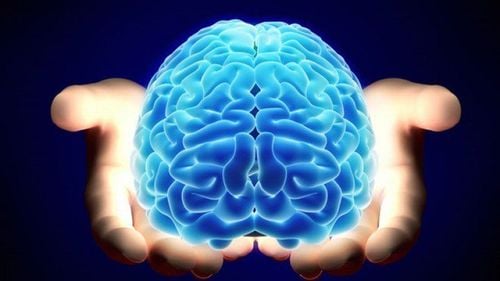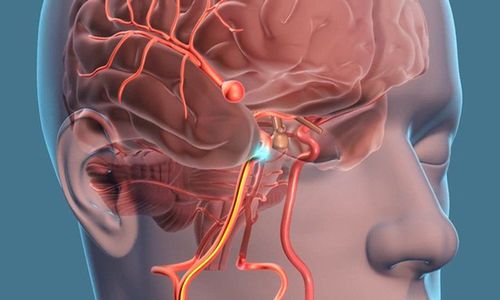This is an automatically translated article.
Cerebral aneurysm is an abnormal bulge of a blood vessel in the brain, which can cause a rupture. This is a very dangerous disease that needs to be detected and treated promptly.
1. What is a cerebral aneurysm?
Cerebral aneurysm is a condition in which blood vessels in the brain swell abnormally. The disease causes brain vessels to leak or burst, causing cerebral hemorrhage.
Cerebral aneurysms usually rupture at the middle cerebral artery or meninges.
Patients with cerebral aneurysms can be life-threatening. A ruptured cerebral artery is a dangerous condition that can cause a stroke, brain damage, and even death if not treated promptly.
2. Causes of cerebral aneurysms
Cerebral aneurysms can occur at any site of a wide or dilated cerebral artery.
Previously, some thought that cerebral aneurysm was due to congenital factors, but now some studies have proved that cerebral aneurysm is caused by:
Microscopic damage of the artery wall Abnormal flow at the bifurcation site of the arteries High blood pressure Drinking alcohol, beer, smoking parasitic fungal infection Bacterial infection Trauma Drugs, cocaine cause inflammation leading to aneurysms.

Tăng huyết áp có thể là nguyên nhân gây phình mạch máu não
3. Signs of cerebral aneurysm
Cerebral aneurysm usually has two types of symptoms:
Symptoms appear from the time the aneurysm is present to before it ruptures had any symptoms before it broke.
The most important sign is the warning sign before the aneurysm burst. About 30-60% of patients experience a warning headache days to weeks before the aneurysm ruptures.
Depending on the type of brain aneurysm, there will be different symptoms.
Cerebral aneurysm rupture: the most characteristic sign is the sudden onset of headaches. Besides, there are some accompanying symptoms such as nausea, vomiting, stiff neck, blurred vision, sensitivity to light, convulsions, loss of consciousness, loss of consciousness, drooping eyelids Cerebral aneurysm, complications of vascular fistula : An enlarged blood vessel leaks a negligible amount of blood, which causes only a sudden and acute headache. But when brain aneurysm and blood vessel leak, it will cause more serious complications. Uncomplicated cerebral aneurysm: in this case, if the aneurysm is too large, it will compress brain and nerve cells, causing the patient to feel: pain under the eyes, dilated pupils, changes in vision pressure, one side of the face may be numb, weak or paresthetic, eyelids drooping. When you see any of the above signs, you should immediately go to a medical facility for timely treatment.
4. Who is prone to brain aneurysms?

Khoảng 5% dân số bị phình mạch máu não
About 5% of the population has cerebral aneurysms. Cerebral aneurysms can occur at any age, any object, but the most common age is from 50-60 years old. Women have a higher incidence of cerebral aneurysms than men. Prevalence increases with age.
Other risks such as high blood pressure, smoking, diabetes ....can increase the risk of brain aneurysm.
Overweight and obese people are at risk of narrowing blood vessels due to atherosclerosis, while underweight subjects are at risk of developing brain aneurysms.
Drug addicts, patients with trauma or damage to blood vessels or complications from certain types of blood infections are at increased risk of developing brain aneurysms.
5. Diagnosis of cerebral aneurysm
To diagnose cerebral aneurysm, the patient will be assigned a computed tomography (CT) scan of the brain. If the patient suddenly has a severe headache, the aneurysm ruptures, in the subarachnoid space, bleeding occurs.
Based on the location of subarachnoid blood on the CT film, the aneurysm position can be determined.
Currently, digital background angiography (DSA) is the gold standard technique for diagnosing brain aneurysms.
To determine the exact size, image, and location of the aneurysm by cerebral angiography. More than 97% of brain aneurysms are detected through CT angiography (CTA).
Magnetic resonance imaging (MRI) and MRI angiography help to visualize the brain in 3D space. With a sensitivity of 87% and a specificity of 92%, MRA can detect brain aneurysms.
Test of cerebrospinal fluid: when the patient has a subarachnoid hemorrhage, the cerebrospinal fluid will have the appearance of red blood cells, this test will be ordered by the doctor if the patient shows signs of rupture. Cerebral vasculature but not visible on CT scan.
Cerebral aneurysm, if detected early and treated promptly, the patient can completely be treated thoroughly with a method suitable to the patient's condition and characteristics of the lesion such as internal intervention. vascular or open surgery.
Cerebral aneurysm is a dangerous disease, with a high risk of sequelae and even death. The disease needs to be detected and treated promptly so as not to affect the health and life of the patient.
Vinmec Da Nang International General Hospital has successfully implemented the technique of plugging cerebral aneurysms with a success rate of > 95%.
Modern equipment supports doctors during surgery as well as the patient's resuscitation process, such as: DSA GE, MRI 3.0, CT 640 series.
Please dial HOTLINE for more information or register for an appointment HERE. Download MyVinmec app to make appointments faster and to manage your bookings easily.













